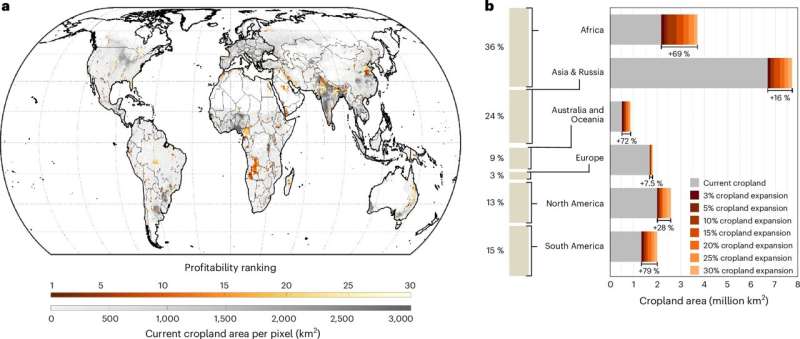
Areas under pressure to expand can potentially increase the current cultivated area by up to 30% without conservation measures. Source: Nature Sustainability (2024). DOI: 10.1038/s41893-024-01410-x
By 2030, global arable land is expected to increase by 3.6 percent and global agricultural production to rise by two percent. This forecast comes from the Food and Agriculture Organization of the United Nations (FAO) and the Organisation for Economic Co-operation and Development (OECD).
An interdisciplinary research team led by Dr. Florian Zabel and Prof. Dr. Ruth Delzeit from the Department of Environmental Sciences at the University of Basel has investigated which areas around the world are most likely to be affected by a future expansion of agriculture. The results of the study are published in the journal Nature Sustainability.
Higher production, more greenhouse gases
The researchers developed a land use model that identifies the most profitable areas worldwide for future agricultural expansion, taking into account socio-economic and agro-ecological criteria. They then assessed the economic and ecological impacts of land use changes in these areas. According to the study, new agricultural areas are likely to emerge primarily in the tropics, where there is still considerable potential for increasing agricultural production despite climate change.
However, since cropland stores much less carbon than the original vegetation, the study estimates that land-use changes would release about 17 gigatons of CO.2 long-term. That is almost half of the current annual global CO2 emissions. In areas affected by land-use changes, biodiversity would also decline by 26%.
“The expansion of agricultural land would therefore be a worrying development, particularly for global climate protection and efforts to preserve biodiversity,” says co-researcher Zabel.
Nature conservation also makes economic sense
Against the backdrop of recent political efforts to protect nature, forests and biodiversity worldwide, the researchers also assessed the impacts of different scenarios of global nature conservation policy and their consequences.
It became clear that nature conservation measures can also have unintended side effects: If the expansion of agricultural land into forests, wetlands and existing protected areas is prohibited by law, this would lead to agricultural use being shifted primarily to grassland areas. This could have a negative impact on the biodiversity of these areas, as grassland areas generally have a higher biodiversity than other areas.
On the other hand, it can also make economic sense to stick to nature conservation. “Contrary to expectations, the preservation of forests, wetlands and existing protected areas has little impact on the gross domestic product of the respective regions.”
“Global agricultural production will also only be reduced slightly. In return, the greenhouse gas emissions caused by the expansion will be significantly reduced,” says lead author Julia Schneider from the Ludwig Maximilian University of Munich.
This result is particularly relevant in the context of global food security: it shows that the conflicts between the provision of agricultural goods and the protection of the environment can be mitigated.
Improving protected area planning
The study makes a valuable contribution to answering the question of which areas are particularly worthy of protection. In the Kunming-Montreal Biodiversity Convention, the international community has set itself the goal of protecting 30 percent of the global land area by 2030.
The current study identifies regions that are particularly at risk in the future and shows what impact the expansion of agriculture could have on the economy and the environment.
“This means that protected areas can be planned in such a way that they have the broadest possible impact on as many goals as possible, such as climate and biodiversity protection, while at the same time taking economic interests into account,” says Zabel.
Further information:
Julia M. Schneider et al, Impacts of profit-oriented farmland expansion and nature conservation policy, Nature Sustainability (2024). DOI: 10.1038/s41893-024-01410-x
Provided by the University of Basel
Quote: Agricultural expansion threatens climate and biodiversity, says land use model (13 August 2024), accessed 13 August 2024 from https://phys.org/news/2024-08-expansion-agricultural-threatens-climate-biodiversity.html
This document is subject to copyright. Except for the purposes of private study or research, no part of it may be reproduced without written permission. The contents are for information purposes only.

